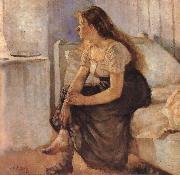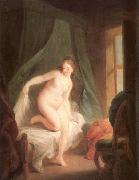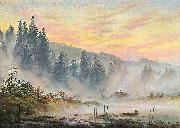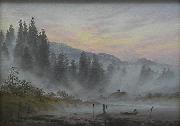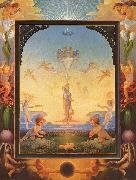Wholesale Oil Painting No Minimum |
|||||||||||
|
|
|||||||||||

|
|||||||||||
|
|
|
||||||||
Edvard MunchNorwegian 1863-1944 Edvard Munch Locations Edvard Munch (pronounced , December 12, 1863 ?C January 23, 1944) was a Norwegian Symbolist painter, printmaker, and an important forerunner of expressionistic art. His best-known composition, The Scream is one of the pieces in a series titled The Frieze of Life, in which Munch explored the themes of life, love, fear, death, and melancholy. Edvard Munch was born in a rustic farmhouse in the village of Adalsbruk in Loten, Norway to Christian Munch, the son of a prominent priest. Christian was a doctor and medical officer, who married Laura Cathrine Bjølstad, a woman half his age, in 1861. Edvard had an older sister, Johanne Sophie (born 1862), and three younger siblings: Peter Andreas (born 1865), Laura Cathrine (born 1867), and Inger Marie (born 1868). Both Sophie and Edvard appear to have gotten their art talent from their mother. Edvard Munch was related to painter Jacob Munch (1776?C1839) and historian Peter Andreas Munch (1810?C1863). The family moved to Kristiania (now Oslo) in 1864 when Christian Munch was appointed medical officer at Akershus Fortress. Edvard??s mother died of tuberculosis in 1868, as did Munch's favorite sister Johanne Sophie in 1877. After their mother's death, the Munch siblings were raised by their father and by their aunt Karen. Often ill for much of the winters and kept out of school, Edvard would draw to keep himself occupied. He also received tutoring from his school mates and his aunt. Christian Munch also instructed his son in history and literature, and entertained the children with vivid ghost stories and tales of Edgar Allan Poe. Christian??s positive behavior toward his children, however, was overshadowed by his morbid pietism. Munch wrote, ??My father was temperamentally nervous and obsessively religious??to the point of psychoneurosis. From him I inherited the seeds of madness. The angles of fear, sorrow, and death stood by my side since the day I was born.?? Christian reprimanded his children by telling them that their mother was looking down from heaven and grieving over their misbehavior. The oppressive religious milieu, plus Edvard??s poor health and the vivid ghost stories, helped inspire macabre visions and nightmares in Edvard, who felt death constantly advancing on him. One of Munch's younger sisters was diagnosed with mental illness at an early age. Of the five siblings only Andreas married, but he died a few months after the wedding. Munch would later write, "I inherited two of mankind's most frightful enemies??the heritage of consumption and insanity." Christian Munch??s military pay was very low, and his attempts at developing a private side practice failed, keeping his family in perrenial poverty. They moved frequently from one sordid flat to another. Munch??s early drawings and watercolors depicted these interiors, and the individual objects such as medicine bottles and drawing implements, plus some landscapes. By his teens, art dominated Munch??s interests. At thirteen, Munch has his first exposure to other artists at the newly formed Art Association, were he admired the work of the Norwegian landscape school, and where he returned to copy the paintings, and soon he began to paint in oils. |
||||||||
|
|
||||||||
The Morning
The Morning Painting ID:: 37927 |
mk130
1884
Oil on canvas
96.5x103.5cm
mk130 1884 Oil on canvas 96.5x103.5cm |
|||||||
|
|
||||||||
LEICHER, Felix IvoAustrian painter b. 1727, Wagstadt, d. 1812, Wien |
||||||||
|
|
||||||||
|
|
The Morning
The Morning Painting ID:: 62443 |
34 x 26 cm Museum of Fine Arts, Budapest The companion-piece of the painting, The Evening, is also in the Budapest museum. Author: LEICHER, Felix Ivo Title: The Morning , 1751-1800 , Austrian Form: painting , genre 34 x 26 cm Museum of Fine Arts, Budapest The companion-piece of the painting, The Evening, is also in the Budapest museum. Author: LEICHER, Felix Ivo Title: The Morning , 1751-1800 , Austrian Form: painting , genre |
||||||
|
|
||||||||
Caspar David Friedrich1774-1840 Caspar David Friedrich Locations German painter, studied art at Copenhagen, and in 1798 settled in Dresden. Friedrich painted chiefly landscapes and seascapes, with and without figures, architectural pictures, including a few of Dresden, and some religious subjects. Religious feeling and symbolism permeate his œuvre, of which the seascape with figures, Die Lebensstufen, is a characteristic example. He possessed considerable power to convey mood in landscape. Almost forgotten in the 19th c. and early 20th c., interest in his work increased considerably in the mid-20th c. He is hardly represented in Britain, but an exhibition of 112 of his pictures at the Tate Gallery in 1972 attracted much attention. F. G. Kersting was a friend of Friedrich. |
||||||||
|
|
||||||||
|
|
The morning
The morning Painting ID:: 71619 |
1820-1821
Oil on canvas
22 x 30.5 cm (8.7 x 12 in)
1820-1821 Oil on canvas 22 x 30.5 cm (8.7 x 12 in) |
||||||
|
|
||||||||
Caspar David Friedrich1774-1840 Caspar David Friedrich Locations German painter, studied art at Copenhagen, and in 1798 settled in Dresden. Friedrich painted chiefly landscapes and seascapes, with and without figures, architectural pictures, including a few of Dresden, and some religious subjects. Religious feeling and symbolism permeate his œuvre, of which the seascape with figures, Die Lebensstufen, is a characteristic example. He possessed considerable power to convey mood in landscape. Almost forgotten in the 19th c. and early 20th c., interest in his work increased considerably in the mid-20th c. He is hardly represented in Britain, but an exhibition of 112 of his pictures at the Tate Gallery in 1972 attracted much attention. F. G. Kersting was a friend of Friedrich. |
||||||||
|
|
||||||||
|
|
The morning
The morning Painting ID:: 73032 |
um 1821
Oil on canvas
22 X 30.5 cm (8.66 X 12.01 in)
cjr um 1821 Oil on canvas 22 X 30.5 cm (8.66 X 12.01 in) cjr |
||||||
|
|
||||||||
Philipp Otto RungeGerman Romantic Painter, 1777-1810 ..German painter, draughtsman and theorist. He stands alongside Caspar David Friedrich as a leading figure in German Romantic painting even though his early death restricted his oeuvre to relatively few stages of development. The enduring prominence of philosophical and theoretical concerns suggests that further work would have contributed to the history of ideas as well as to that of art. Runge's greatest influence was on later, largely 20th-century artists and thinkers rather than on his immediate contemporaries. While 19th-century developments certainly bore out Runge's claim for a new, symbolic role for landscape, |
||||||||
|
|
||||||||
|
|
The Morning
The Morning Painting ID:: 80118 |
1808
Oil on canvas
106 x 81 cm
cjr 1808 Oil on canvas 106 x 81 cm cjr |
||||||
|
|
||||||||
|
Philipp Otto Runge German Romantic Painter, 1777-1810 ..German painter, draughtsman and theorist. He stands alongside Caspar David Friedrich as a leading figure in German Romantic painting even though his early death restricted his oeuvre to relatively few stages of development. The enduring prominence of philosophical and theoretical concerns suggests that further work would have contributed to the history of ideas as well as to that of art. Runge's greatest influence was on later, largely 20th-century artists and thinkers rather than on his immediate contemporaries. While 19th-century developments certainly bore out Runge's claim for a new, symbolic role for landscape, The Morning 1808 Oil on canvas 106 x 81 cm cjr |
||||||||
|
|
||||||||
|
Prev Next
|
||||||||
|
|
||||||||
|
Related Paintings to Philipp Otto Runge :. |
||||||||
|
|
||||||||
|
CONTACT US |
